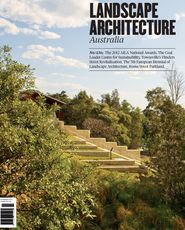We live in one of the world’s most urbanized nations. Nearly eight out of ten Australians live in just seventeen cities hugging the narrow coastal strip of our vast island continent 1 yet paradoxically, we still have not come to terms with our urbanity. So much of our daily existence is shaped by the urban settings in which we live, learn and work. Of necessity then, landscape architects will, and must have, a more visible role in influencing how those different but interconnected settings support our capacity as Australians to prosper and live better lives.
Just how well are we designing and developing our cities and what part are landscape architects actually playing in improving urban quality? More than fifty years ago the notable architect Robin Boyd, in his then controversial book The Australian Ugliness (Penguin Books, 1960), wrote despairingly about the aesthetic condition of our cities and their landscapes. Fast-forward to 2012 and I think our cities are better places than the ones Boyd was so critical of in the 1960s. Travel around most Australian cities and towns and one can see ample evidence of progress and of greater care for public environments. For me, the projects recognized by the 2012 AILA National Awards are further proof of advancement, not only in the urban condition but also of the landscape architecture profession’s contribution to the high quality of life we enjoy in this country. To keep things in perspective, however, compared to other international cities, Australian cities’ quality-of-life rankings are declining.2
There is an adage that good projects need good clients (or sentiments to that effect). What strikes me about this year’s AILA National Awards is the strong representation of government clients and the fact that as a result, many of the awards were for urban public projects. A couple of observations need to be made about this trend. Governments, at whatever level they govern, must set a clear urban policy framework and establish benchmarks for how we as a profession interpret and then respond to those policy settings. It must be more a case of “do as we do and not do as we say.” Pleasingly, this is increasingly the case from public agencies but there still remains considerable scope for improvement, particularly at the local authority level.
All of the awarded public projects contribute to reinforcing those benchmarks in the eyes of their actual clients – the community at large, the place users. The demand for better public spaces, for new parks, promenades and playgrounds, for more sophisticated planning and greater innovation must fundamentally emanate from an appreciative public, from a citizenry who, having experienced the pleasure they derive as users, can lobby government for more.
Just how many Australians would be able to “join the dots” and correctly identify the hands of landscape architects in creating the external public and private spaces they enjoy? Many I think would, but as a profession we can do more in publicly talking about our roles in creating and delivering projects that demonstrably improve our wellbeing, whether it is in urban or natural settings. This is not about self-promotion but rather greater advocacy for what we believe in as a profession and how we do it.
My observation about the award recipients prompted me to think about how integral we are as a profession to the future of cities. While Boyd didn’t specifically talk about the role of landscape architects in redressing the “ugliness” he saw in our urban environment, I’m certain that any contemporary commentator would acknowledge that the landscape architect’s role is pivotal. Pivotal not only because the challenges confronting cities globally are more complex but because so much of what will shape our response – environmentally, socially and economically – should and must come from the field of landscape architecture; from a profession not on the periphery but at the epicentre of the search for, and application of, new ideas and new solutions. In essence, it needs to be about leadership because as a profession we are uniquely placed to provide the “intellectual glue” needed to stick the disparate parts of the urban puzzle together.
As a profession I believe we still have so much more to contribute than perhaps the private sector and the wider community recognizes. Is it because our contribution is currently subsumed or masked by the roles of others more adept at influencing and communicating their contribution? Or is it because we still too easily accept our position further back in the queue? Occasionally I hear the odd cynical remark about the value of professional award programs, usually from other built environment practitioners feeling jaded about their lack of success or about the vagaries of judging panels. I don’t harbour such negative thoughts because I think awards by the profession, for the profession, are in reality not about the profession. Rather they are recognition of the ultimate beneficiaries of our work – society as a whole. We must, therefore, continue to demonstrate and more stridently communicate the value of our involvement.
A final reflection would be a plea to see more entries at the precinct, or even city-wide, scale – ground-breaking, big-picture strategies that have been instigated by landscape architects and which propose solutions drawing on the insights our training and thinking provides; and landscape architecture on a larger canvas confident in its capacity to tackle the “wicked problems” confronting urban Australia.
The AILA National Awards is therefore an indicator of our health as a profession; an informative pointer to our progress in how we practise landscape architecture in this country. I think anyone reviewing the awards both in terms of their diversity and quality would objectively observe that we appear to be in good shape but that with greater maturity and a louder voice, the prospects for even greater success are strong. It’s up to us to take those next important steps.
Congratulations to all the award recipients – you can be proud of your achievements.
1,2. Infrastructure Australia “State of Australian Cities 2010” report.
Source

Discussion
Published online: 1 Nov 2012
Words:
Malcolm Snow
Issue
Landscape Architecture Australia, November 2012














